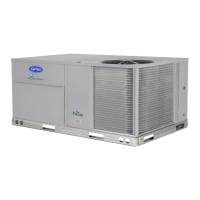39
Setting EC.TS=ON will perform the following:
1. Command S.VFD to STATPMIN.
2. Open E.POS to 100% and let run 5 minutes.
3. Verify SAT=OAT ± AC_EC_DB.
4. Close E.POS to 0% and let run 5 minutes.
5. Verify SAT=RAT ± AC_EC_DB.
6. End test.
If SAT=OAT ± AC_EC_DB when E.POS=100% and
SAT=RAT ± AC_EC_DB when E.POS=0%, EC.ST=PASS,
otherwise EC.ST=FAIL.
Humidi-MiZer Auto-Component Test — The Hu-
midi-MiZer auto-component test requires the following condi-
tions:
1. Unit is not shut down due to failure (A152).
2. D.SEL=DH - HUMDZR (Humidi-MiZer system is con-
figured to perform dehumidification).
3. No compressors are on or requested on.
4. Compressor A1 is available to start.
Test screen will display the following:
The Humidi-MiZer auto-component test will verify Hu-
midi-MiZer operation in cooling, subcooling and reheat
modes. It will perform this test by commanding compressor B1
ON, adjusting RHV (3-way reheat valve), C.EXV (condenser
modulating valve) and B.EXV ( bypass modulating valve), and
comparing SAT to EDT (evaporator discharge temperature).
Setting HZ.TS=ON will perform the following:
1. Command compressor B1, supply fan, and condenser
fans ON.
2. Run cooling mode by setting RHV=OFF, C.EXV=100%,
B.EXV=0%.
3. Allow to run for 5 minutes and verify SAT=>EDT. Re-
cord SAT and EDT.
4. Run subcooling mode by setting RHV=ON,
C.EXV=100%, B.EXV=0%.
5. Allow to run for 5 minutes and verify EDT is less than the
value recorded in Step 3 and SAT - EDT > 2 F.
6. Run reheat mode by setting RHV=ON, C.EXV=0%,
B.EXV=100%.
7. Allow to run for 5 minutes and verify SAT-EDT>5 F.
8. End test.
If all SAT/EDT comparisons are verified, HZ.ST=PASS,
otherwise HZ.ST=FAIL.
THIRD PARTY CONTROL
Thermostat —
The method of control would be through
the thermostat inputs:
Y1 = first stage cooling
Y1 and Y2 = first and second stage cooling
W1 = first stage heating
W1 and W2 = first and second stage heating
G = supply fan
Alarm Output — The alarm output is 24-v at TB201-X
and TB201-C. The contact will provide relay closure whenever
the unit is under an alert or alarm condition (5 va maximum).
Remote Switch — The remote switch may be configured
for three different functions. Under Configuration
UNIT, set
RM.CF to one of the following:
0 = no remote switch
1 = occupied/unoccupied switch
2 = start/stop switch
3 = occupancy override switch
Under Configuration
IAQ
SW.LG, RMI.L, the remote
occupancy switch can be set to either a normally open or nor-
mally closed switch input. Normal is defined as either unoccu-
pied, start or “not currently overridden,” respective to the
RM.CF configuration.
With RM.CF set to 1, no time schedules are followed and
the unit follows the remote switch only in determining the state
of occupancy.
With RM.CF set to 2, the remote switch can be used to shut
down and disable the unit, while still honoring timeguards on
compressors. Time schedules, internal or external, may be run
simultaneously with this configuration.
With RM.CF set to 3, the remote input may override an un-
occupied state and force the control to go occupied mode. As
with the start/stop configuration, an internal or external time
schedule may continue to control occupancy when the switch
is not in effect.
VFD Control — Supply duct static pressure control of the
VFD driving the supply fan may be left under unit control or be
externally controlled. To control the VFD externally with a 4 to
20 mA signal, set SP.RS to 4 (VFD CONTROL), under the
Configuration
SP menu. This will set the reset to VFD con-
trol. When SP.RS = VFD CONTROL, the static pressure reset
function acts to provide direct VFD speed control where 4 mA
= 0% speed and 20 mA = 100% (SP.MN and SP.MX will over-
ride). Note that SP.CF must be set to 1 (ENABLE) prior to
configuring SP.RS = VFD CONTROL. Failure to do so could
result in damage to ductwork due to overpressurization.
In effect, this represents a speed control signal "pass
through" under normal operating circumstances. The Com-
fortLink controller overrides the third party signal for critical
operation situations, most notably smoke and fire control.
Wire the input to the controls expansion module (CEM) us-
ing TB202-6 and TB202-7. An optional CEM board is
required.
See Appendix D and the VFD literature supplied with the
unit for further information on the VFD.
Supply Air Reset — With the installation of the control
expansion module (CEM), the ComfortLink controls are capa-
ble of accepting a 4 to 20 mA signal, to reset the supply-air
temperature up to a maximum of 20 F.
Under Configuration
EDT.R set RS.CF to 3 (4-20 SA
RSET - external 4 to 20 mA supply air reset control). The 4 to
20 mA input to the control system (TB202-9 and TB202-8),
will be linearized and range from 0° to 20 F. For example, 4
mA = 0° F reset, 12 mA = 10° F reset and 20 mA = 20° F reset.
Demand Limit Control — The term demand limit con-
trol refers to the restriction of the machine's mechanical cooling
capacity to control the amount of power that a machine may
use.
Demand limiting is possible via two means:
Two discrete inputs tied to demand limit set point percentages.
OR
A 4 to 20 mA input that can reduce or limit capacity linearly to
a set point percentage.
HZ.TS ON
RHV OFF
C.EXV 100%
B.EXV 0%
EDT 55 F
SAT 55 F
HZ.ST Running

